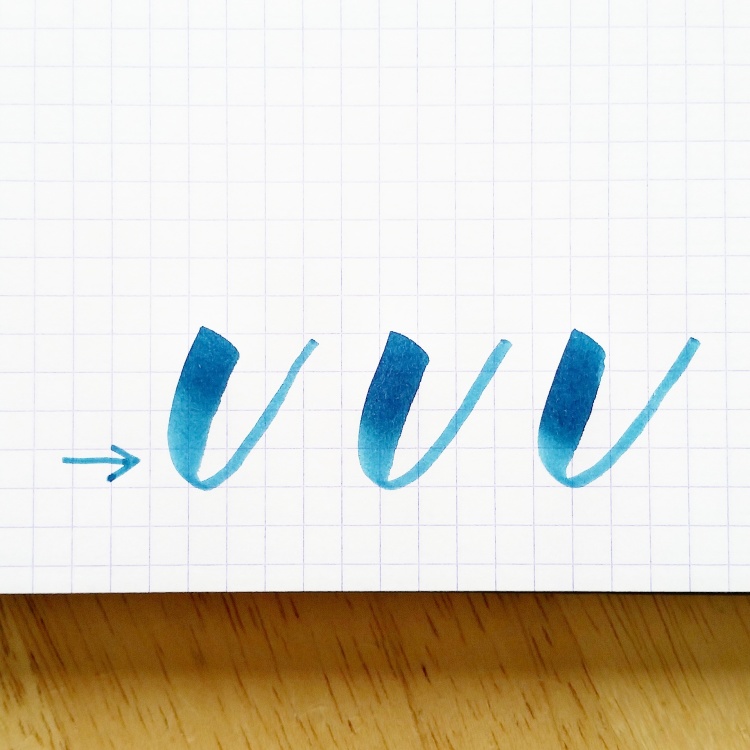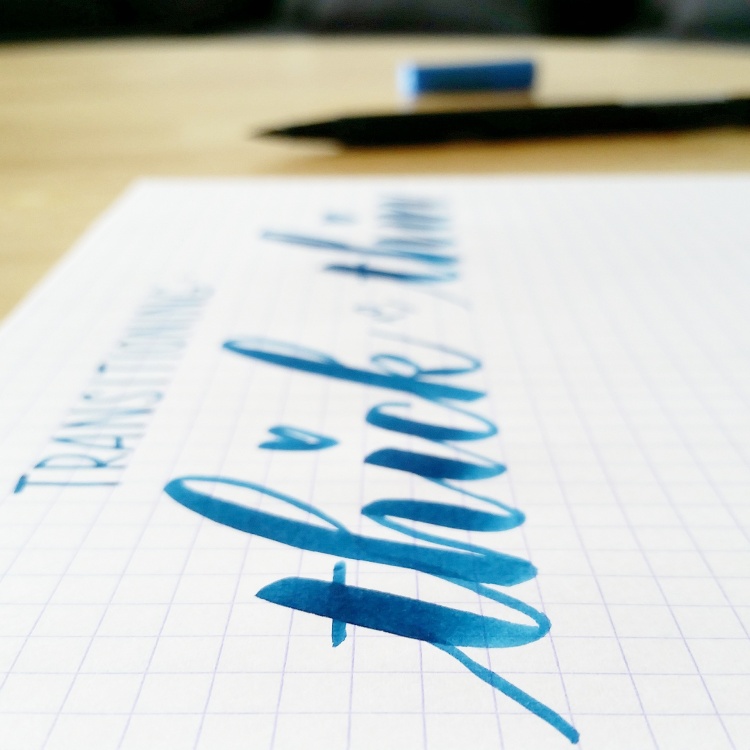Mastering when and how to transitioning your brush calligraphy stroke from thick to thin can be extremely frustrating.
Trust me, I know.
I know because I was there just over a year ago. And honestly, I still struggle with this skill even now.
But the good news is, you get to hear my best tips I have learned over this past year.
In this post, you will learn about my best tips for transitioning from thick to thin strokes and vice versa. You will read about key concepts for improving your brush calligraphy.
At the end of this post, I want you to start practicing these skills TODAY – do not just write for the sake of writing. Be intentional. Be mindful of each stroke. This is not a race to the finish line. This is about your journey to improve.
Highlights from this post:
- Know your pen: Every pen is different, everyone’s level of comfort is different, and yet every pen has its sweet spot for achieving your desired stroke width.
- Transition before you reach the baseline: When transitioning from thick to thin, you actually want to start exerting less pressure before you reach the baseline.
- Go slow (and then slower): There will be a time to go fast. This is not one of them. Do not rush or else you risk making mistakes, being inconsistent, or failing to truly grasp this important concept.

Know your pen
One of the most important beginning concepts of brush calligraphy mastering your grip on the brush pen. The angle at which you hold it really makes a difference in your ability to achieve that thick and thin stroke variation. And then direction your pen faces plays an even bigger role in the look of your strokes.
Every pen is different, everyone’s level of comfort is different, and every pen has its own unique sweet spot for achieving your desired stroke width.
Read back on these previous posts to learn more about improving your grip and positioning of the brush pen:
- How to hold your brush pen
- How to hold your brush pen at an angle
- Pointing your brush pen in the proper direction
Transition before you reach the baseline
When transitioning from thick to thin, you actually want to start exerting less pressure before you reach the baseline.
Once you fully understand this concept and apply it to your writing, you will see much improvement.
When I first started doing brush calligraphy, I did not pay attention to this concept. I simply wrote. My brush calligraphy was not bad, but there was so much to improve on!
Take a look at what I mean by transitioning before you reach the baseline:

In my photo above, notice how the transition begins before reaching the baseline. In order to achieve this transition, you need to gradually start exerting less pressure. Slowly begin lifting your pen, but don’t do this too fast.
By the time your each the baseline, your stroke should be at the very thinnest.
This skill is tricky!
It is easy to see it and understand it, but transferring that knowledge into your hand and onto the page takes a lot of practice and time. So that is why I am here: To help you practice, improve, and save time in figuring this all out yourself.
Tead more about how and when to apply pressure in this post: How to apply pressure.
Go slow (and then slower)
There will be a time to write fast. I promise.
This is not one of them.
Do not rush, or else you risk making mistakes, being inconsistent, and failing to truly grasp this important concept.
If you are anything like me, you are impatient and eager. You fight the urge to rush through your brush calligraphy in hopes that you pick up these skills over time.
Listen to me: You are not missing out by going slow. In fact, you are doing yourself a huge favor by slowing down and mastering these core skills.

Take time to practice each chance you get. It doesn’t have to be for hours, or even one hour. But the more you touch the pen, learn how it writes, and practice your strokes, you will slowly gain more control and understand how to achieve the brush calligraphy you desire.
Remember to Strive for thin strokes, not hairlines
One of the sources of that frustration is striving for strokes that are as thin as a hairline. Remember, you need not hold yourself to this expectation. There are more important and crucial concepts you must grasp and achieve before you should focus on how thin your upstrokes are.
Yes, the upstroke should be thinner than the downstroke. But so long as there is a distinct contrast between the two strokes, it is perfectly fine if your upstroke is not as thin as a hairline.
Video: Transitioning thick to thin strokes
Watch this video below to see thick to thin stroke transitions in action!
~ ~ ~
It’s your turn! Tell me in a comment below:
What has worked for you to improve your thick to thin transitions?
What is the one thing you are still struggling with when it comes to transitioning from thick to thin lines?
~ ~ ~
P.S. If you liked this post, please share it with a friend!
P. P. S. If you haven’t already done so, subscribe to my blog below so you get my posts directly in your inbox!
Follow me on Instagram: @piecescalligraphy


Wonderful tips. Thank you.
LikeLike
Excellent post! I figured out why your brush strokes have that beautiful fade in the bottom of the downstrokes: it’s because of the release in pressure leading to the upstroke!!! So as I’m practicing, I noticed my letters started to look more like yours…using a darker color with a sharper contrast with pressure is helpful in seeing if i am letting up on the pressure at the right point! Thank you so much!!!
LikeLike
This post was so helpful! Now, I know when to apply less pressure on the upstroke. My u’s are looking so much better! Thank you for sharing all your knowledge on brush calligraphy!
LikeLike
Thanks for this post! I always need the reminder to slow down!!! I get too excited, I think 😊
LikeLike
Thank you so much! Your posts always help me so much and I really love the videos! Whats helped me a lot with transitioning it just practice and slowing down a lot! I’ve always wondered why your brush call. strokes always have a dark to lightness on every stroke now I know I’t’s because you where already transitioning!!! = )
LikeLike
Thank you! This tip has improved my brush lettering so much!!
LikeLike
I’m so happy to hear, Sara!
LikeLike